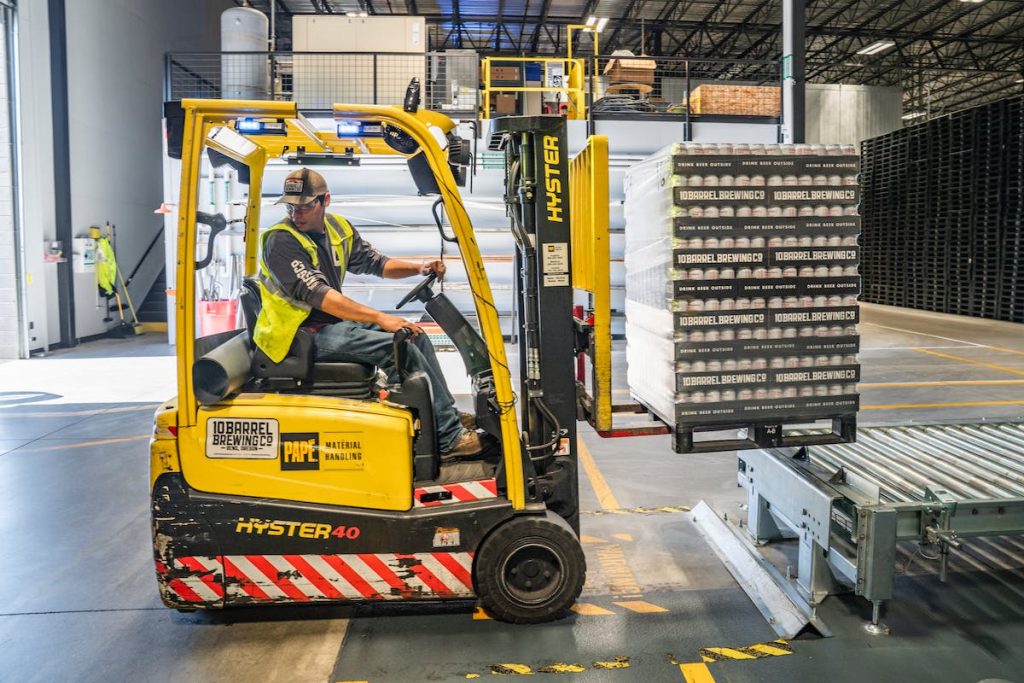
Investing in quality material handling equipment is vital for efficient warehouse operations, reducing handling errors and costs.- Types of material handling equipment include forklifts, conveyors, pallet jacks, and Automated Guided Vehicles (AGVs).
- Before purchasing, consider your warehouse layout, type of goods, and budget to choose the right equipment.
- Regular maintenance and safety training for employees are crucial to ensure optimal equipment functionality and workplace safety.
- The right material handling equipment can improve warehouse efficiency and give your business a competitive edge.
As a business owner who operates a warehouse, you already know how important it is to streamline your warehouse processes, reduce handling errors, and improve operational efficiency. One of the most significant ways to achieve this is by investing in quality material handling equipment. Material handling equipment assists in moving and storing goods in the warehouse, such as loading and unloading materials, transporting products, and maintaining inventory. In modern societies such as Singapore, Japan, and Germany, material handling equipment is highly advanced and automated so that businesses can achieve a competitive edge.
This comprehensive guide aims to navigate you through the purchasing process of material handling equipment. You will discover the importance of investing in quality equipment, factors to consider before buying, and various types of warehousing material handling equipment available on the market.
The Importance of Investing in Quality Material Handling Equipment
Firstly, investing in quality material handling equipment is essential for an efficient warehouse operation. Material handling equipment should be sturdy, durable, and designed to meet the specific needs of your warehouse. Quality material handling equipment reduces handling errors and damage to products, leading to a decrease in costs associated with repairing damages or injuries due to mishandling.
Moreover, quality material handling equipment also increases productivity by reducing the time spent on manual handling tasks. This ensures that warehouse employees can focus on other value-adding tasks that can improve the overall efficiency of warehouse operations.
Types of Material Handling Equipment
There are various types of material handling equipment available on the market. Depending on your warehouse’s specific needs, you can choose from the following:
Forklifts
Forklifts are one type of equipment used for loading and unloading heavy goods. They come in various sizes, including counterbalance forklifts and reach trucks, making them versatile for different warehouse layouts. Always consider the weight, size, and lifting capacity when looking for a modern forklift for sale.

Conveyors
Conveyors are ideal for transporting goods within the warehouse without manual handling. These automated systems come in different styles, including belt, roller, and chain conveyors. They can be customized to fit your warehouse layout and optimize the flow of goods.
Pallet Jacks
Pallet jacks are manual or electric-powered equipment used for moving pallets within the warehouse. They are commonly used in smaller warehouses or when handling light loads. Compared to forklifts, pallet jacks can require less maintenance but may have limited lifting capacity.
Automated Guided Vehicles (AGVs)
AGVs are self-driving vehicles that navigate through the warehouse using sensors or magnets embedded in the floor. They can be used for various tasks such as transporting goods, picking orders, and loading/unloading materials. AGVs are ideal for warehouses with a high volume of repetitive tasks and are known to increase efficiency and reduce costs.
Factors to Consider Before Buying Material Handling Equipment
Before investing in material handling equipment, it is crucial to consider several factors. As each warehouse has its unique needs, it is essential to assess your specific requirements and select equipment that best meets them. Some factors to consider include:
Warehouse Layout
Your warehouse layout will determine the type and size of equipment you can use. Ensure that your chosen equipment can navigate through your warehouse’s aisles and reach all storage areas. If your warehouse has narrow aisles, you may need to consider equipment specifically designed for tight spaces.

Type of Goods
The type of goods in your warehouse will also determine the equipment needed. For example, if you handle fragile or perishable goods, you may need specialized equipment such as temperature-controlled storage units or forklift attachments.
Budget
It is essential to determine your budget and stick to it when purchasing material handling equipment. While quality equipment may come at a higher price, it is crucial to balance the cost with the potential benefits and long-term savings in efficiency.
Maintenance and Safety Considerations
Once you have invested in quality material handling equipment, it is crucial to maintain it regularly. Scheduling regular inspections and repairs ensures that the equipment is functioning correctly and minimizes the risk of safety incidents. It is also essential to train employees on the proper use and handling of the equipment, ensuring that they follow all safety guidelines and protocols.
Moreover, when operating equipment in the warehouse, it is important to remain vigilant about any potential safety hazards. Keeping walkways clear, providing adequate lighting in high-risk areas, and ensuring that employees are trained on the proper use of equipment can all help to prevent accidents and injuries.
Investing in quality material handling equipment is essential for any business owner who operates a warehouse. By considering factors such as warehouse layout, type of goods, and budget, you can select the right equipment to streamline your warehouse processes and improve efficiency. Remember to prioritize maintenance and safety considerations to ensure that your investment continues to benefit your business in the long run. With the right material handling equipment, you can achieve a competitive edge and set your warehouse up for success.



